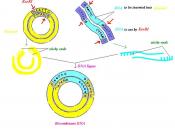GENETIC ENGINEERING Scientists are trying to figure out the entire three billion-letter human genome with high precision as a prelude to figuring out eventually what protein each gene produces and for what purpose. It all started in 1866 when Austrian botanist and monk Gregor Mendel proposed basic laws of heredity based on crossbreeding experiments with pea plants. His findings, published in a local natural-history journal, were largely ignored for more than thirty years. In 1910 U.S. biologist Thomas Hunt Morgan's experiment with fruit flies reveal that some genetically determined traits are sex linked. His work also confirms that the genes determining these traits reside on chromosomes. It continuos until 1997 when researchers at Scotland's Roslin Institute, led by embryologist Lan Wilmut, reported that they cloned a sheep-named Dolly-from the cell of an adult ewe. The next goal of scientists is to sequence all human DNA by 2003, the Human Genome Projects current target date (Lemonick 46).
But we should use genetic engineering in a proper way. Our goal should be to find areas where it is needed rather than try to misuse it for personal gain. Genetic engineering can provide medical benefits to humans, but limits have to be set.
The Code of Life Our body contains one hundred trillion cells, inside most cells is a nucleus that contains a complete set of the body's blueprints. Those blueprints are twisted into forty-six packets called chromosomes. Unravel a chromosome, and you get the long, thread-like molecule called DNA. Within the DNA are the blueprints, called genes, for which make proteins. The DNA molecule has a twisted, laddershaped structure (the famous double helix). The genetic code can be read in the rungs of the ladder. The code is spelled out by four chemicals: adenine (A), thymine (T), guanine (G), and cytosine (C).


